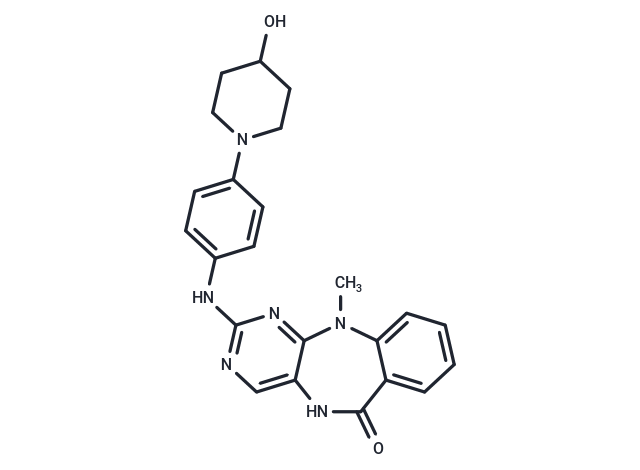Shopping Cart
- Remove All
 Your shopping cart is currently empty
Your shopping cart is currently empty

XMD16-5 is a TNK2 inhibitor. TNK2 genomic amplification has been associated with late-stage or metastatic lung and prostate Ys. Overexpression of TNK2 promoted metastasis in a mouse model of breast Y. TNK2 signaling is disrupted in breast, prostate and gastrointestinal tumors.

| Pack Size | Price | Availability | Quantity |
|---|---|---|---|
| 1 mg | $37 | In Stock | |
| 2 mg | $51 | In Stock | |
| 5 mg | $92 | In Stock | |
| 10 mg | $147 | In Stock | |
| 25 mg | $237 | In Stock | |
| 50 mg | $437 | In Stock | |
| 100 mg | $648 | In Stock | |
| 500 mg | $1,380 | In Stock | |
| 1 mL x 10 mM (in DMSO) | $92 | In Stock |
| Description | XMD16-5 is a TNK2 inhibitor. TNK2 genomic amplification has been associated with late-stage or metastatic lung and prostate Ys. Overexpression of TNK2 promoted metastasis in a mouse model of breast Y. TNK2 signaling is disrupted in breast, prostate and ga |
| Targets&IC50 | R806Q:77 nM, D163E:16nM |
| In vitro | XMD16-5 is found to be potent in the inhibition of TNK2 phosphorylation. XMD8-87 and XMD16-5 potently inhibit phosphorylation of TNK2 truncation mutations found in solid tumor types. |
| Kinase Assay | Kinase targets are tested with biochemical enzymatic kinase assays using the SelectScreen Kinase Profiling Service to determine IC50 values. The compounds (XMD16-5) are assayed at 10 concentrations (3-fold serial dilutions starting from 1 μM) at an ATP concentration equal to the ATP Km[1]. |
| Cell Research | 293T cells expressing TNK2 are plated in 6-well format at a density of 250,000 cells per well 48 hours prior to treatment. Cells are then treated with a 100 μL of XMD8-87 or XMD16-5 at 5 μmol/L and with 9 1:1 serial dilutions down to ≈10 nmol/L. Two additional samples are treated with DMSO only. Cells are then incubated for 6 hours at 37°C. Protein extraction is accomplished by adding 300 μL of lysis buffer to cells after removing media. Plates are gently shaken for 5 minutes at room temperature. Lysates are collected and cleared of incompletely solubilized material by spinning for 10 minutes at maximum speed in a microcentrifuge. Samples are prepared for SDS-PAGE using the EPage loading buffer.(Only for Reference) |
| Molecular Weight | 416.48 |
| Formula | C23H24N6O2 |
| Cas No. | 1345098-78-3 |
| Smiles | CN1c2ccccc2C(=O)Nc2cnc(Nc3ccc(cc3)N3CCC(O)CC3)nc12 |
| Relative Density. | 1.347 g/cm3 (Predicted) |
| Storage | Powder: -20°C for 3 years | In solvent: -80°C for 1 year | Shipping with blue ice. | ||||||||||||||||||||||||||||||||||||||||
| Solubility Information | DMSO: 45 mg/mL (108.05 mM), Sonication is recommended. H2O: < 1 mg/mL (insoluble or slightly soluble) Ethanol: 5 mg/mL (12.01 mM), Sonication is recommended. | ||||||||||||||||||||||||||||||||||||||||
Solution Preparation Table | |||||||||||||||||||||||||||||||||||||||||
Ethanol/DMSO
DMSO
| |||||||||||||||||||||||||||||||||||||||||

Copyright © 2015-2025 TargetMol Chemicals Inc. All Rights Reserved.